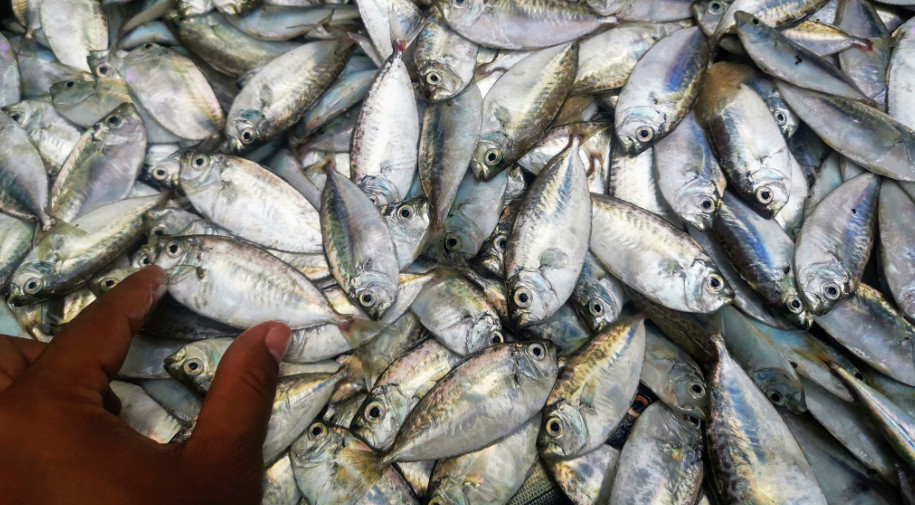Tabilos fish, also known as Pope’s ponyfish, is a species of marine ray-finned fish, a ponyfish from the family Leiognathidae. It has a wide Indo-Pacific distribution, which extends from the Red Sea east to the western Pacific Ocean. It has entered the Mediterranean as a Lessepsian migrant.
The scientific name of Tabilos fish Equulites popei is named after the British ichthyologist Clifford Hillhouse Pope. Other common names include striped ponyfish, Leiognathus popei, and Gazza minuta. Tabilos is Ilonggo and Cebuano terms, and there is no known equivalent in Tagalog as this fish is abundant in waters surrounding the Negros Island.

Tabilos Fish Description
Equulites popei is a small fish, typically growing to a maximum length of about 15 cm (6 in). It has a slender, elongated body with a pointed snout. The head and ventral body are silvery white, while the dorsal body is silvery brown with scattered dark blotches. The pectoral axil is dark, and the pectoral fin is pale yellow. The caudal fin has black lines along the rays, and the posterior margin of the caudal fin is dark.
Tabilos fish is found in shallow coastal waters, typically in areas with sandy or muddy bottoms. It is a schooling fish and is often associated with seagrass beds and coral reefs. It feeds on small crustaceans and other invertebrates.
The taste of Equulites popei is mild and slightly sweet. It is a popular food fish in many parts of its range.
Here are some of the physical characteristics of Tabilos Fish
- Body: Slender and elongated, with a pointed snout.
- Head: Small, with a large mouth.
- Eyes: Large and well-developed.
- Scales: Small and cycloid.
- Fins: Dorsal fin with eight spines and 16 soft rays; anal fin with three spines and 14 soft rays.
- Color: Silvery white with scattered dark blotches on the dorsal body.
How to Prepare and Cook Tabilos
Tabilos fish is a relatively small fish, but it is an integral part of the marine ecosystem. It is a prey fish for larger fish and sharks and helps control populations of small crustaceans and other invertebrates.
Equulites popei can be prepared and cooked in many different ways, depending on the desired taste and texture.
Fresh
Fresh Tabilos fish can be grilled, pan-fried, or baked. To grill, brush the fish with olive oil and season with salt and pepper. Grill over medium heat for 3-4 minutes per side or until cooked through. To pan-fry, heat some olive oil in a pan over medium heat. Add the fish and cook for 2-3 minutes per side or until cooked through. Preheat oven to 400 degrees F (200 degrees C) to bake. Place the fish in a baking dish and season with salt and pepper. Bake for 10-12 minutes, or until cooked through.
Dried
Dried Equulites popei can be rehydrated and cooked in the same way as fresh fish. To rehydrate, place the fish in a bowl of cold water and soak for 30 minutes or until soft.
Fillet
Also, Tabilos is not usually filleted due to its size; its bones are removed when kinilaw is made. Tabilos is very popupar for kinilaw lovers. Fillets can be cooked in various ways, such as pan-frying, grilling, or baking. To pan-fry, heat some olive oil in a pan over medium heat. Add the fillets and cook for 2-3 minutes per side or until cooked through. To grill, brush the fillets with olive oil and season with salt and pepper. Grill over medium heat for 3-4 minutes per side or until cooked. Preheat oven to 400 degrees F (200 degrees C) to bake. Place the fillets in a baking dish and season with salt and pepper. Bake for 10-12 minutes, or until cooked through.
Canned or Bottled
Equulites popei can be found canned or bottled in brine or oil. Canned or bottled fish can be rinsed in various dishes, such as salads, soups, or stews.
Fermented
Equulites popei can also be fermented. Fermented fish is a popular dish with a strong, salty flavor in many cultures.
No matter how you prepare and cook Tabilos fish, it is a delicious and nutritious fish that can be enjoyed in many different ways.
Here are some additional tips for preparing and cooking Tabilos:
- If you are using fresh fish, gut it and clean it properly.
- If you are using dried fish, rehydrate it in cold water for 30 minutes before cooking.
- Be careful not to overcook the fish, which will become tough and dry.
- Equulites popei can be paired with various flavors, so experiment with different seasonings and sauces.
See Also:
- Dapa Fish: 10 Health Benefits of Flatfish, Description, and Side Effects
- Banak: 10 Health Benefits of Mullet Fish Description and Side Effects
- 9 Health Benefits of Ackee Fruit, Description, and Side Effects
- 7 Health Benefits of Akebi Fruit, Description, and Side Effects
- Acai Farming: How to Plant and Grow Acai
